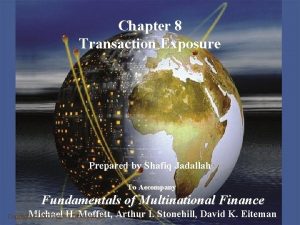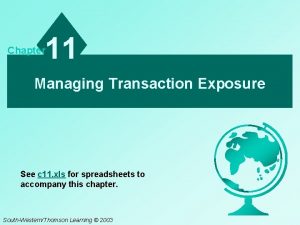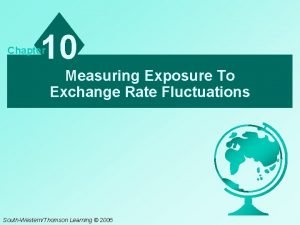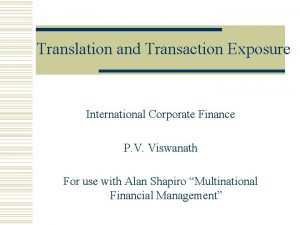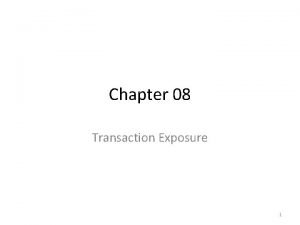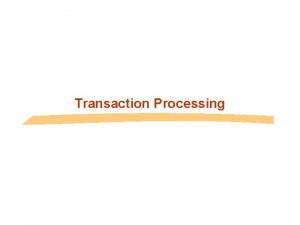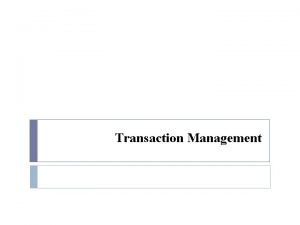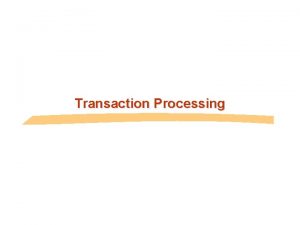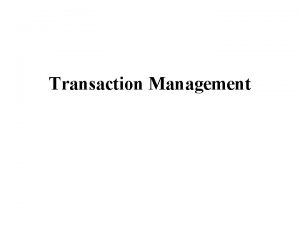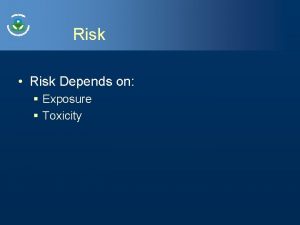Measuring FX Exposure Transaction Exposure 1 FX Risk











- Slides: 11

Measuring FX Exposure Transaction Exposure 1

FX Risk Management FX Exposure: Review • At the firm level, currency risk is called exposure. • TE is simply to calculate: Value in DC of a specific transaction wit a certain date/maturity denominated in FC. • We can measure TE, and analyze the sensitivity of TE to changes in St. - Use a statistical distribution or a simulation. The less sensitive TE is to St, the lower the need to pay attention to ef, t. • MNCs have measures for NTE for: - a single transaction - all transactions (Netting, where co-movements of St‘s are incorporated

• The last measure approaches TE with a portfolio approach, where currency correlations are taken into account. Correlations: Brief Review Recall that the co-movement between two random variables can be measured by the correlation coefficient. The correlation between the random variables X and Y is given by: Corr(X, Y) = XY/( Y Y). Interpretation of the correlation coefficient ( xy [-1, 1]): If xy = 1, X changes by 10%, Y also changes by 10%. If xy = 0, X changes by 10%, Y is not affected --(linearly) independent. If xy = -1, X changes by 10%, Y also changes by -10%.

Currencies from developed countries tend to move together. . . But, not always!

Netting MNC take into account the correlations among the major currencies to calculate Net TE Portfolio Approach. A U. S. MNC: Subsidiary A with CF(in EUR) > 0 Subsidiary B with CF(in GBP) < 0 GBP, EUR is very high and positive. Net TE might be very low for this MNC. • Hedging decisions are usually not made transaction by transaction. Rather, they are made based on the exposure of the portfolio.

Example: Swiss Cruises. Net TE (in USD): USD 1 million. Due: 30 days. Loan repayment: CAD 1. 50 million. Due: 30 days. St = 1. 47 CAD/USD. CAD, USD =. 924 (from 1990 to 2001) Swiss Cruises considers the Net TE (overall) to be close to zero. ¶ Note 1: Correlations vary a lot across currencies. In general, regional currencies are highly correlated. From 2000 -2007, the GBP and EUR had an average correlation of . 71, while the GBP and the MXN had an average correlation of -. 01. Note 2: Correlations also vary over time.


● Sensitivity Analysis for portfolio approach Do a simulation: assume different scenarios -- attention to correlations! Example: IBM has the following CFs in the next 90 days FC Outflows Inflows St Net Inflows GBP 100, 000 25, 000 1. 60 USD/GBP (75, 000) EUR 80, 000 200, 000 1. 05 USD/EUR 120, 000 NTE (USD)= EUR 120 K*1. 05 USD/EUR+(GBP 75 K)*1. 60 USD/GBP = USD 6, 000 (this is our baseline case) Situation 1: Assume GBP, EUR = 1. (EUR and GBP correlation is high. ) Scenario (i): EUR appreciates by 10% against the USD (ef, EUR, t=. 10). St = 1. 05 USD/EUR * (1+. 10) = 1. 155 USD/EUR Since GBP, EUR = 1 => St = 1. 60 USD/GBP * (1+. 10) = 1. 76 USD/GBP

Example (continuation): Scenario (ii): EUR depreciates by 10% against the USD (ef, EUR, t=-. 10). St = 1. 05 USD/EUR * (1 -. 10) = 0. 945 USD/EUR Since GBP, EUR = 1 => St = 1. 60 USD/GBP * (1 -. 10) = 1. 44 USD/GBP NTE (USD)=EUR 120 K*0. 945 USD/EUR+(GBP 75 K)*1. 44 USD/GBP = USD 5, 400. (-10% change) Now, we can specify a range for NTE ∈ [USD 5, 400, USD 6, 600] Note: The NTE change is exactly the same as the change in St. If a firm has matching inflows and outflows in highly positively correlated currencies –i. e. , the NTE is equal to zero-, then changes in St do not affect NTE. That’s very good.

Example (continuation): Situation 2: Suppose the GBP, EUR = -1 (NOT a realistic assumption!) Scenario (i): EUR appreciates by 10% against the USD (ef, EUR, t=. 10). St = 1. 05 USD/EUR * (1+. 10) = 1. 155 USD/EUR Since GBP, EUR = -1 => St = 1. 60 USD/GBP * (1 -. 10) = 1. 44 USD/GBP NTE (USD)= EUR 120 K*1. 155 USD/EUR+(GBP 75 K)*1. 44 USD/GBP = USD 30, 600. (410% change) Scenario (ii): EUR depreciates by 10% against the USD (ef, EUR, t=-. 10). St = 1. 05 USD/EUR * (1 -. 10) = 0. 945 USD/EUR Since GBP, EUR = -1 => St = 1. 60 USD/GBP * (1+. 10) = 1. 76 USD/GBP NTE (USD)=EUR 120 K*0. 945 USD/EUR+(GBP 75 K)*1. 76 USD/GBP = (USD 18, 600). (-410% change)

Example (continuation): Note: The NTE has ballooned. A 10% change in exchange rates produces a dramatic increase in the NTE range. Having non-matching exposures in different currencies with negative correlation is very dangerous. • Considerations for IBM can assume a distribution (say, bivariate normal) with a given correlation (estimated from the data) and, then, draw many scenarios for the St’s to generate an empirical distribution for the NTE. From this simulated distribution, IBM will get a range –and a VAR- for the NTE. IBM can assume a correlation from the ED and, then, jointly draw –i. e. , draw together a pair, ef, GBP, t & ef, EUR, t– many scenarios for St to generate an empirical distribution for the NTE. From this ED, IBM will get a range –and a Va. R- for the NTE. ¶
 Transaction exposure and economic exposure
Transaction exposure and economic exposure Operating exposure vs transaction exposure
Operating exposure vs transaction exposure Market risk assessment
Market risk assessment Transaction exposure คือ
Transaction exposure คือ Managing transaction exposure
Managing transaction exposure Management of transaction exposure
Management of transaction exposure Exchange rate fluctuations
Exchange rate fluctuations Define translation exposure
Define translation exposure What is transaction exposure
What is transaction exposure Transaction exposure example
Transaction exposure example Managing economic exposure and translation exposure
Managing economic exposure and translation exposure Managing economic exposure and translation exposure
Managing economic exposure and translation exposure



